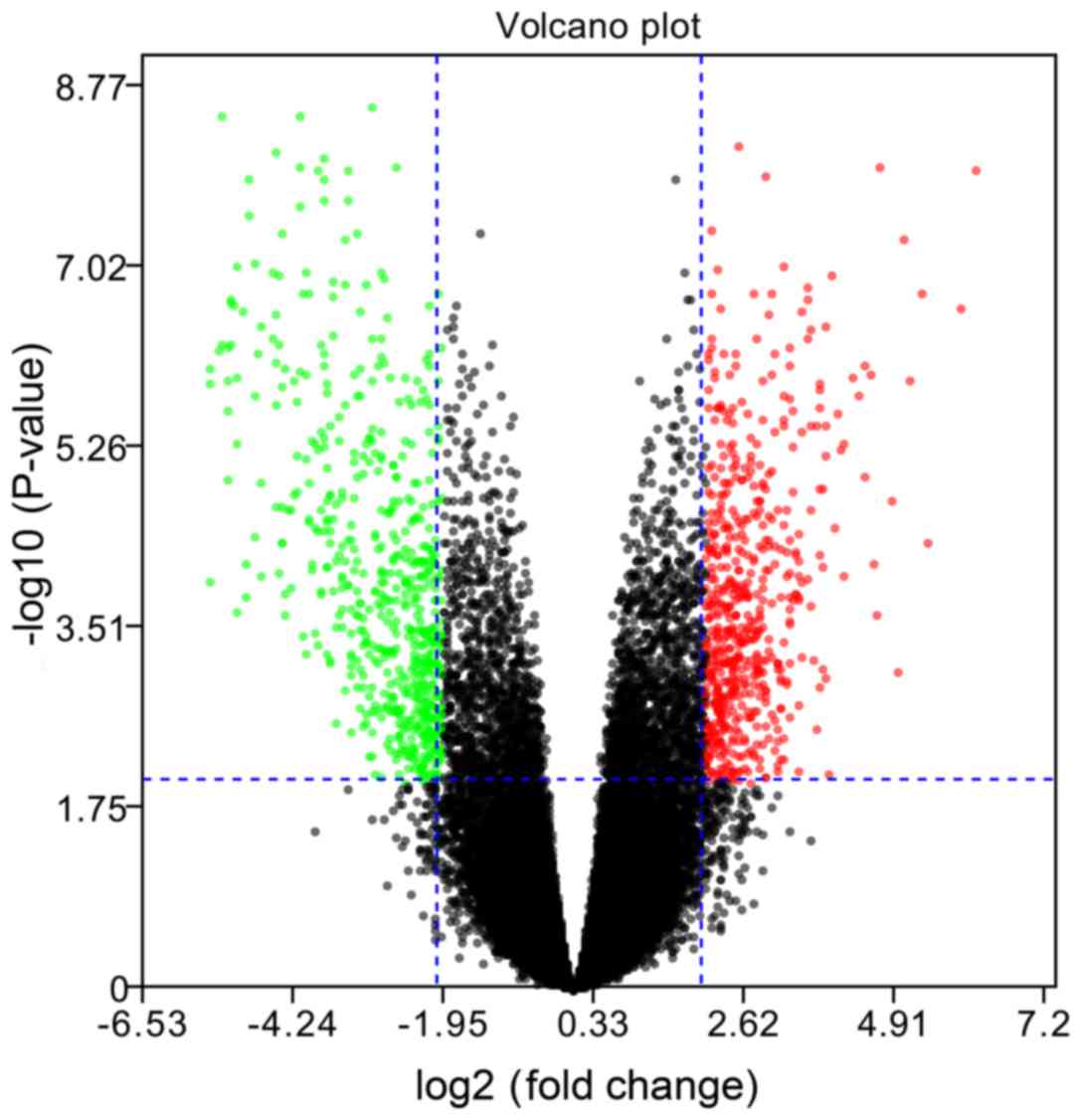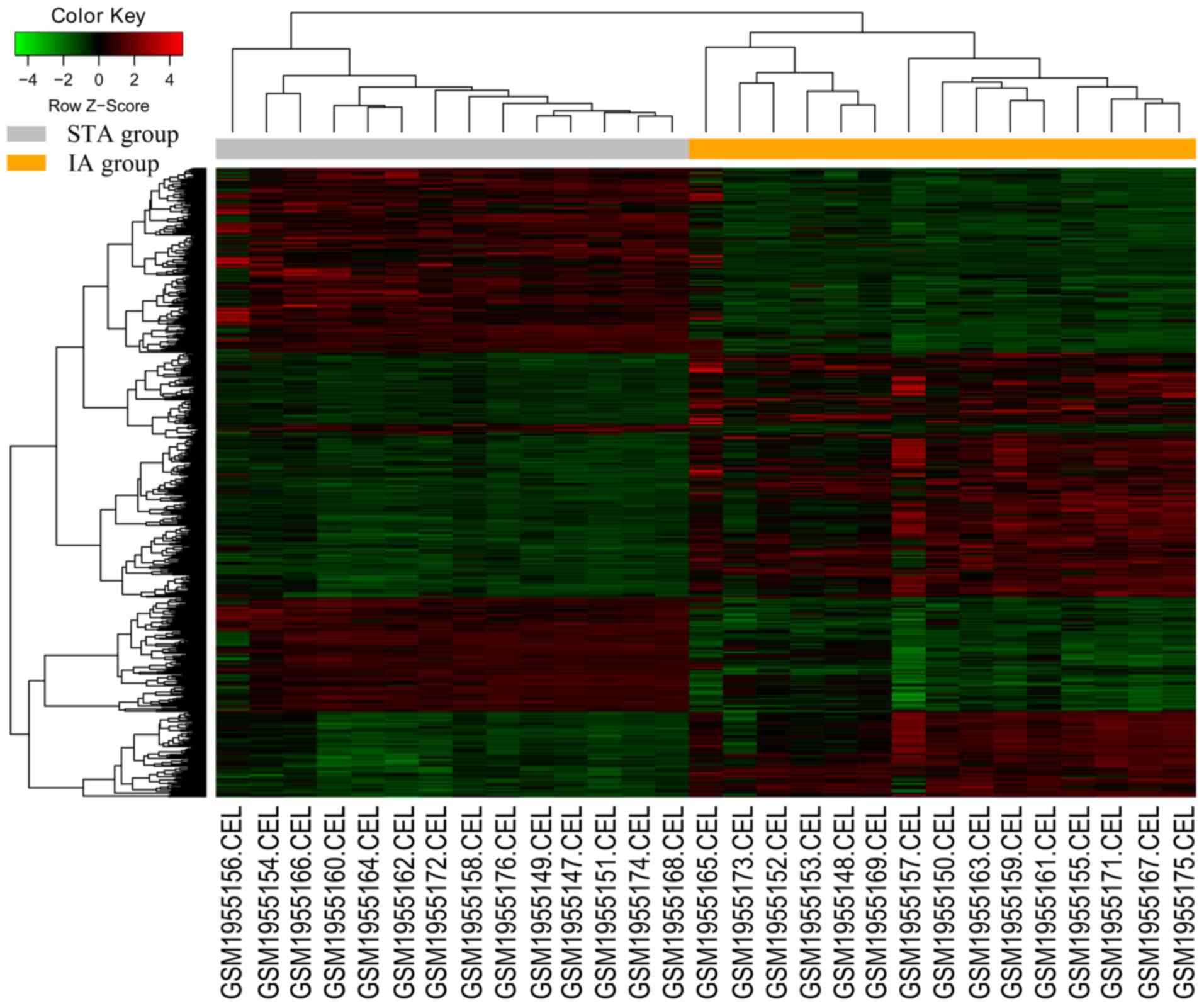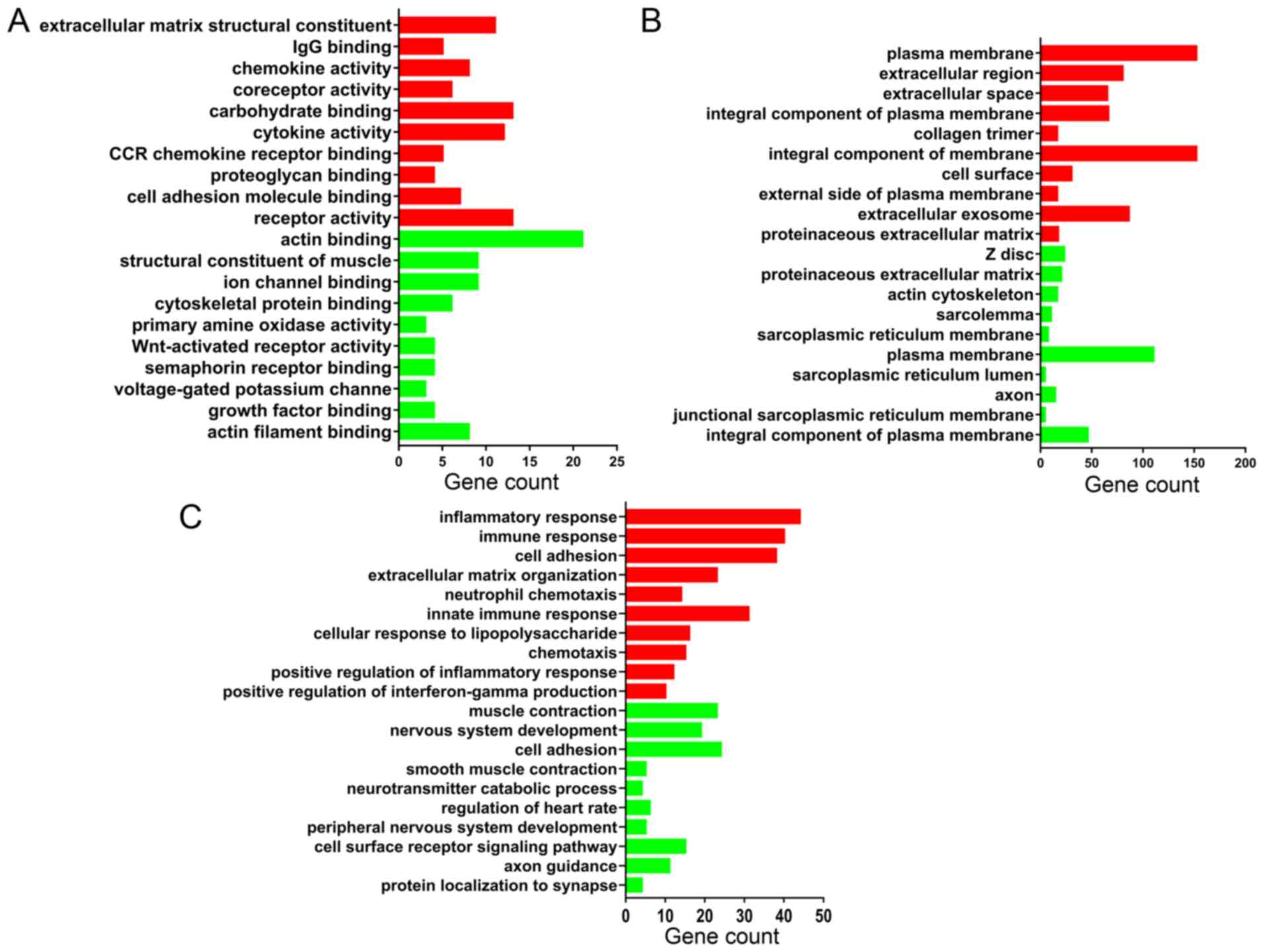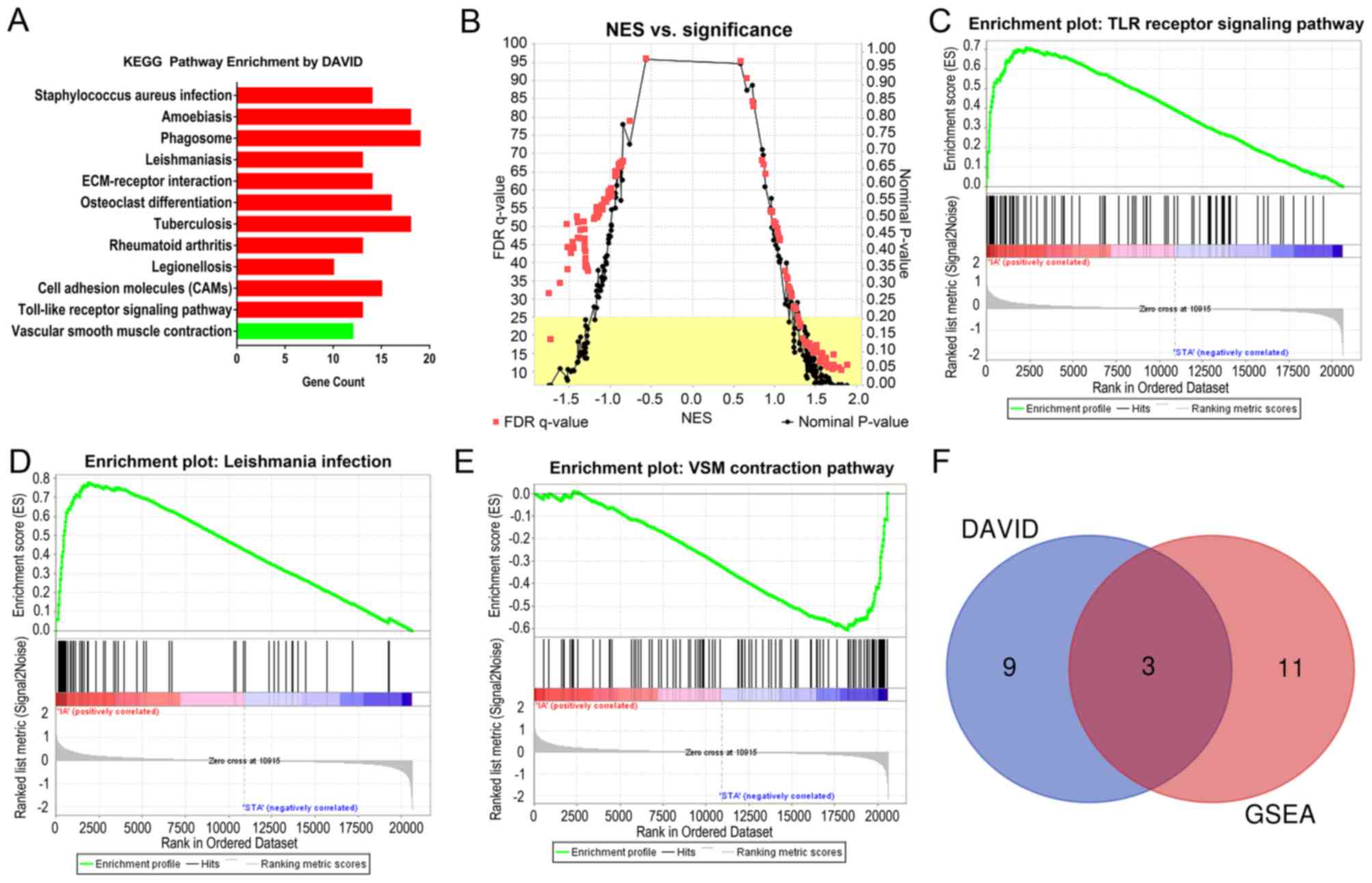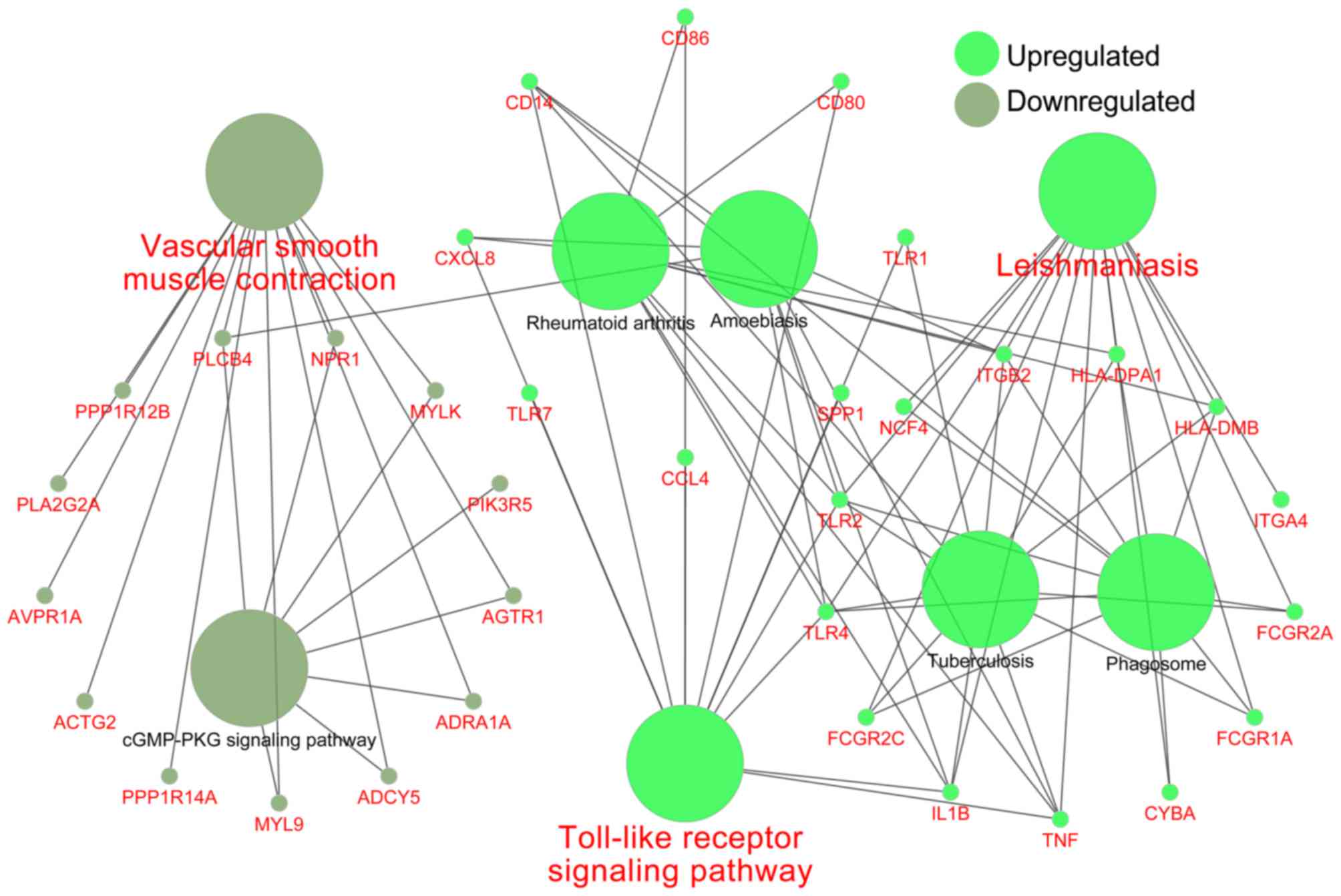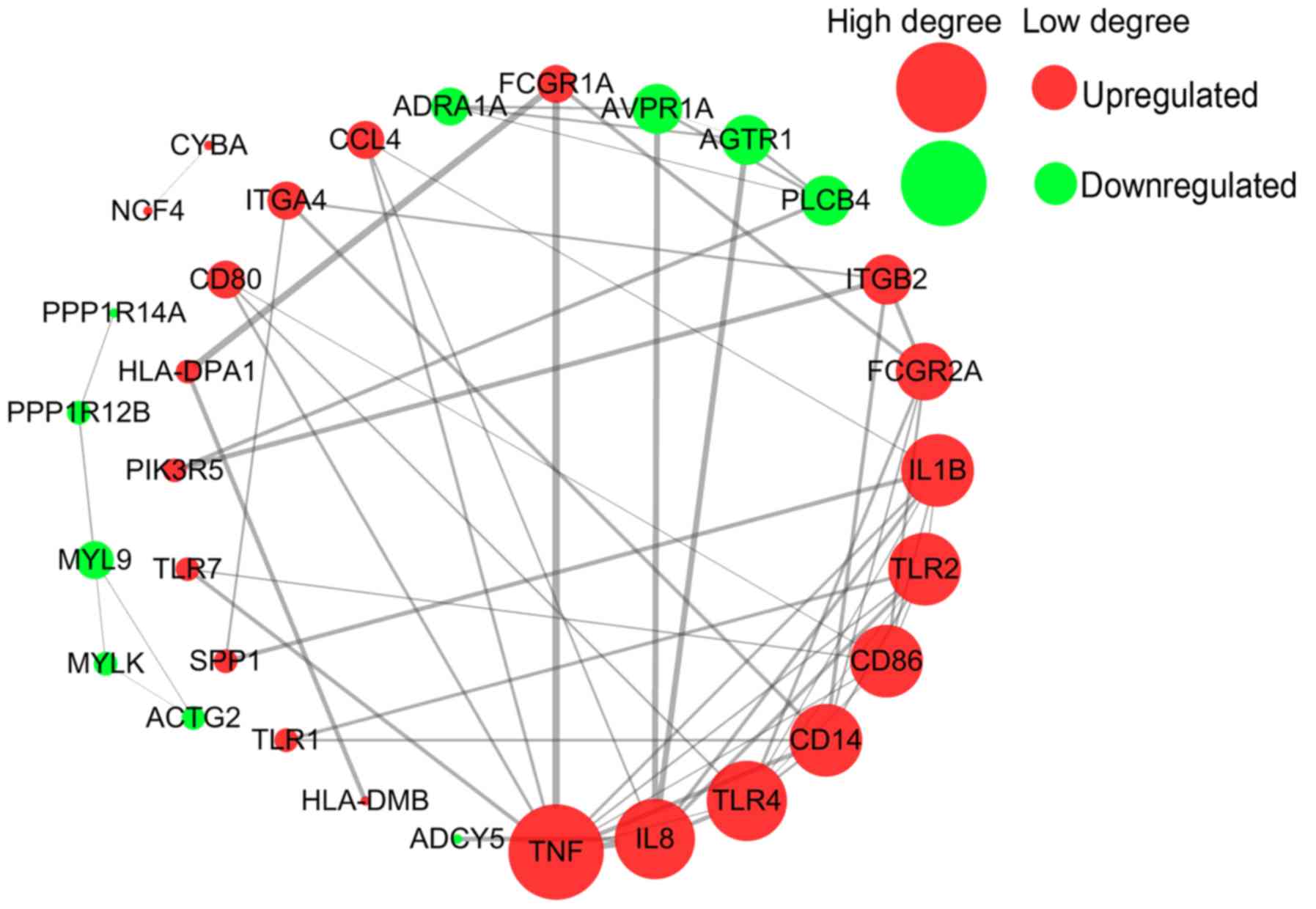|
1
|
Johnston SC, Selvin S and Gress DR: The
burden, trends, and demographics of mortality from subarachnoid
hemorrhage. Neurology. 50:1413–1418. 1998. View Article : Google Scholar : PubMed/NCBI
|
|
2
|
Lovelock CE, Rinkel GJ and Rothwell PM:
Time trends in outcome of subarachnoid hemorrhage: Population-based
study and systematic review. Neurology. 74:1494–1501. 2010.
View Article : Google Scholar : PubMed/NCBI
|
|
3
|
Macdonald RL and Schweizer TA: Spontaneous
subarachnoid haemorrhage. Lancet. 389:655–666. 2017. View Article : Google Scholar : PubMed/NCBI
|
|
4
|
Etminan N and Rinkel GJ: Cerebral
aneurysms: Cerebral aneurysm guidelines-more guidance needed. Nat
Rev Neurol. 11:490–491. 2015. View Article : Google Scholar : PubMed/NCBI
|
|
5
|
Etminan N and Rinkel GJ: Unruptured
intracranial aneurysms: Development, rupture and preventive
management. Nat Rev Neurol. 12:699–713. 2016. View Article : Google Scholar : PubMed/NCBI
|
|
6
|
Bilguvar K, Yasuno K, Niemela M, Ruigrok
YM, von Und Zu Fraunberg M, van Duijn CM, van den Berg LH, Mane S,
Mason CE, Choi M, et al: Susceptibility loci for intracranial
aneurysm in European and Japanese populations. Nat Genet.
40:1472–1477. 2008. View
Article : Google Scholar : PubMed/NCBI
|
|
7
|
Vlak MH, Rinkel GJ, Greebe P and Algra A:
Independent risk factors for intracranial aneurysms and their joint
effect: A case-control study. Stroke. 44:984–987. 2013. View Article : Google Scholar : PubMed/NCBI
|
|
8
|
Meng H, Tutino VM, Xiang J and Siddiqui A:
High WSS or low WSS? Complex interactions of hemodynamics with
intracranial aneurysm initiation, growth, and rupture: Toward a
unifying hypothesis. AJNR Am J Neuroradiol. 35:1254–1262. 2014.
View Article : Google Scholar : PubMed/NCBI
|
|
9
|
Chalouhi N, Hoh BL and Hasan D: Review of
cerebral aneurysm formation, growth, and rupture. Stroke.
44:3613–3622. 2013. View Article : Google Scholar : PubMed/NCBI
|
|
10
|
Edgar R and Barrett T: NCBI GEO standards
and services for microarray data. Nat Biotechnol. 24:1471–1472.
2006. View Article : Google Scholar : PubMed/NCBI
|
|
11
|
Wei L, Wang Q, Zhang Y, Yang C, Guan H,
Chen Y and Sun Z: Identification of key genes, transcription
factors and microRNAs involved in intracranial aneurysm. Mol Med
Rep. 17:891–897. 2018.PubMed/NCBI
|
|
12
|
Bo L, Wei B, Wang Z, Li C, Gao Z and Miao
Z: Bioinformatic analysis of gene expression profiling of
intracranial aneurysm. Mol Med Rep. 17:3473–3480. 2018.PubMed/NCBI
|
|
13
|
Wang W, Li H, Yu L, Zhao Z, Wang H, Zhang
D, Zhang Y, Lan Q, Wang J and Zhao J: Aberrant expression of
lncRNAs and mRNAs in patients with intracranial aneurysm.
Oncotarget. 8:2477–2484. 2017.PubMed/NCBI
|
|
14
|
Benjamini Y and Yekutieli D: The control
of the false discovery rate in multiple testing under dependency.
Ann Statistics. 29:1165–1188. 2001.
|
|
15
|
Tulamo R, Frosen J, Hernesniemi J and
Niemela M: Inflammatory changes in the aneurysm wall: A review. J
Neurointerv Surg. 2:120–130. 2010. View Article : Google Scholar : PubMed/NCBI
|
|
16
|
van Kuijk JP, Flu WJ, Chonchol M, Bax JJ,
Verhagen HJ and Poldermans D: Metabolic syndrome is an independent
predictor of cardiovascular events in high-risk patients with
occlusive and aneurysmatic peripheral arterial disease.
Atherosclerosis. 210:596–601. 2010. View Article : Google Scholar : PubMed/NCBI
|
|
17
|
Starke RM, Chalouhi N, Ding D, Raper DM,
Mckisic MS, Owens GK, Hasan DM, Medel R and Dumont AS: Vascular
smooth muscle cells in cerebral aneurysm pathogenesis. Transl
Stroke Res. 5:338–346. 2014. View Article : Google Scholar : PubMed/NCBI
|
|
18
|
Bennett MR, Sinha S and Owens GK: Vascular
smooth muscle cells in atherosclerosis. Circ Res. 118:692–702.
2016. View Article : Google Scholar : PubMed/NCBI
|
|
19
|
Lim S and Park S: Role of vascular smooth
muscle cell in the inflammation of atherosclerosis. BMB Rep.
47:1–7. 2014. View Article : Google Scholar : PubMed/NCBI
|
|
20
|
Troutman TD, Bazan JF and Pasare C:
Toll-like receptors, signaling adapters and regulation of the
pro-inflammatory response by PI3K. Cell Cycle. 11:3559–3567. 2012.
View Article : Google Scholar : PubMed/NCBI
|
|
21
|
Cole JE, Kassiteridi C and Monaco C:
Toll-like receptors in atherosclerosis: A ‘Pandora's box’ of
advances and controversies. Trends Pharmacol Sci. 34:629–636. 2013.
View Article : Google Scholar : PubMed/NCBI
|
|
22
|
Garcia Bueno B, Caso JR, Madrigal JL and
Leza JC: Innate immune receptor Toll-like receptor 4 signalling in
neuropsychiatric diseases. Neurosci Biobehav Rev. 64:134–147. 2016.
View Article : Google Scholar : PubMed/NCBI
|
|
23
|
Ha T, Liu L, Kelley J, Kao R, Williams D
and Li C: Toll-like receptors: New players in myocardial
ischemia/reperfusion injury. Antioxid Redox Signal. 15:1875–1893.
2011. View Article : Google Scholar : PubMed/NCBI
|
|
24
|
McCarthy CG, Goulopoulou S, Wenceslau CF,
Spitler K, Matsumoto T and Webb RC: Toll-like receptors and
damage-associated molecular patterns: Novel links between
inflammation and hypertension. Am J Physiol Heart Circ Physiol.
306:H184–H196. 2014. View Article : Google Scholar : PubMed/NCBI
|
|
25
|
Rakoff-Nahoum S and Medzhitov R: Toll-like
receptors and cancer. Nat Rev Cancer. 9:57–63. 2009. View Article : Google Scholar : PubMed/NCBI
|
|
26
|
Subramanian S, Tus K, Li QZ, Wang A, Tian
XH, Zhou J, Liang C, Bartov G, McDaniel LD, Zhou XJ, et al: A Tlr7
translocation accelerates systemic autoimmunity in murine lupus.
Proc Natl Acad Sci USA. 103:9970–9975. 2006. View Article : Google Scholar : PubMed/NCBI
|
|
27
|
Okun E, Griffioen KJ and Mattson MP:
Toll-like receptor signaling in neural plasticity and disease.
Trends Neurosci. 34:269–281. 2011. View Article : Google Scholar : PubMed/NCBI
|
|
28
|
Goulopoulou S, McCarthy CG and Webb RC:
Toll-like receptors in the vascular system: Sensing the dangers
within. Pharmacol Rev. 68:142–167. 2016. View Article : Google Scholar : PubMed/NCBI
|
|
29
|
Gonzalez-Ramos M, Calleros L, Lopez-Ongil
S, Raoch V, Griera M, Rodríguez-Puyol M, de Frutos S and
Rodríguez-Puyol D: HSP70 increases extracellular matrix production
by human vascular smooth muscle through TGF-β1 up-regulation. Int J
Biochem Cell Biol. 45:232–242. 2013. View Article : Google Scholar : PubMed/NCBI
|
|
30
|
Li H, Xu H and Sun B: Lipopolysaccharide
regulates MMP-9 expression through TLR4/NF-κB signaling in human
arterial smooth muscle cells. Mol Med Rep. 6:774–778. 2012.
View Article : Google Scholar : PubMed/NCBI
|
|
31
|
Ruvolo G, Pisano C, Candore G, Lio D,
Palmeri C, Maresi E and Balistreri CR: Can the TLR-4-mediated
signaling pathway be ‘a key inflammatory promoter for sporadic
TAA’? Mediators Inflamm. 2014:3494762014. View Article : Google Scholar : PubMed/NCBI
|
|
32
|
Balistreri CR, Ruvolo G, Lio D and Madonna
R: Toll-like receptor-4 signaling pathway in aorta aging and
diseases: ‘Its double nature’. J Mol Cell Cardiol. 110:38–53. 2017.
View Article : Google Scholar : PubMed/NCBI
|
|
33
|
Kurki MI, Hakkinen SK, Frosen J, Tulamo R,
von und zu Fraunberg M, Wong G, Tromp G, Niemelä M, Hernesniemi J,
Jääskeläinen JE and Ylä-Herttuala S: Upregulated signaling pathways
in ruptured human saccular intracranial aneurysm wall: An emerging
regulative role of Toll-like receptor signaling and nuclear
factor-κB, hypoxia-inducible factor-1A, and ETS transcription
factors. Neurosurgery. 68:1666–1675. 2011. View Article : Google Scholar
|
|
34
|
Kumar R, Singh OP, Gautam S, Nylen S and
Sundar S: Enhanced expression of Toll-like receptors 2 and 4, but
not 9, in spleen tissue from patients with visceral leishmaniasis.
Parasite Immunol. 36:721–725. 2014. View Article : Google Scholar : PubMed/NCBI
|
|
35
|
Chandel HS, Pandey SP, Roy S, Doyen N and
Saha B: TLR-CD40 cross-talk in anti-leishmanial immune response.
Front Immunol. 5:2202014. View Article : Google Scholar : PubMed/NCBI
|
|
36
|
Masopust D and Picker LJ: Hidden memories:
Frontline memory T cells and early pathogen interception. J
Immunol. 188:5811–5817. 2012. View Article : Google Scholar : PubMed/NCBI
|
|
37
|
Jin B, Sun T, Yu XH, Yang YX and Yeo AE:
The effects of TLR activation on T-cell development and
differentiation. Clin Dev Immunol. 2012:8364852012. View Article : Google Scholar : PubMed/NCBI
|
|
38
|
Li J, Lee DS and Madrenas J: Evolving
bacterial envelopes and plasticity of TLR2-dependent responses:
Basic research and translational opportunities. Front Immunol.
4:3472013. View Article : Google Scholar : PubMed/NCBI
|
|
39
|
Netea MG, Sutmuller R, Hermann C, Van der
Graaf CA, Van der Meer JW, van Krieken JH, Hartung T, Adema G and
Kullberg BJ: Toll-like receptor 2 suppresses immunity against
Candida albicans through induction of IL-10 and regulatory T cells.
J Immunol. 172:3712–3718. 2004. View Article : Google Scholar : PubMed/NCBI
|
|
40
|
Garate I, Garcia-Bueno B, Madrigal JL,
Caso JR, Alou L, Gomez-Lus ML, Micó JA and Leza JC: Stress-induced
neuroinflammation: Role of the Toll-like receptor-4 pathway. Biol
Psychiatry. 73:32–43. 2013. View Article : Google Scholar : PubMed/NCBI
|
|
41
|
Esen N and Kielian T: Toll-like receptors
in brain abscess. Curr Top Microbiol Immunol. 336:41–61.
2009.PubMed/NCBI
|
|
42
|
Ali MS, Starke RM, Jabbour PM, Tjoumakaris
SI, Gonzalez LF, Rosenwasser RH, Owens GK, Koch WJ, Greig NH and
Dumont AS: TNF-α induces phenotypic modulation in cerebral vascular
smooth muscle cells: Implications for cerebral aneurysm pathology.
J Cereb Blood Flow Metab. 33:1564–1573. 2013. View Article : Google Scholar : PubMed/NCBI
|
|
43
|
Moriwaki T, Takagi Y, Sadamasa N, Aoki T,
Nozaki K and Hashimoto N: Impaired progression of cerebral
aneurysms in interleukin-1beta-deficient mice. Stroke. 37:900–905.
2006. View Article : Google Scholar : PubMed/NCBI
|
|
44
|
Frosen J, Tulamo R, Paetau A, Laaksamo E,
Korja M, Laakso A, Niemelä M and Hernesniemi J: Saccular
intracranial aneurysm: Pathology and mechanisms. Acta Neuropathol.
123:773–786. 2012. View Article : Google Scholar : PubMed/NCBI
|
|
45
|
Sakaki T, Kohmura E, Kishiguchi T, Yuguchi
T, Yamashita T and Hayakawa T: Loss and apoptosis of smooth muscle
cells in intracranial aneurysms. Studies with in situ DNA end
labeling and antibody against single-stranded DNA. Acta Neurochir
(Wien). 139:469–475. 1997. View Article : Google Scholar : PubMed/NCBI
|
|
46
|
Chalouhi N, Ali MS, Jabbour PM,
Tjoumakaris SI, Gonzalez LF, Rosenwasser RH, Koch WJ and Dumont AS:
Biology of intracranial aneurysms: Role of inflammation. J Cereb
Blood Flow Metab. 32:1659–1676. 2012. View Article : Google Scholar : PubMed/NCBI
|
|
47
|
Starke RM, Chalouhi N, Jabbour PM,
Tjoumakaris SI, Gonzalez LF, Rosenwasser RH, Wada K, Shimada K,
Hasan DM, Greig NH, et al: Critical role of TNF-α in cerebral
aneurysm formation and progression to rupture. J Neuroinflammation.
11:772014. View Article : Google Scholar : PubMed/NCBI
|
|
48
|
Fontanella M, Rainero I, Gallone S, Rubino
E, Fenoglio P, Valfrè W, Garbossa D, Carlino C, Ducati A and
Pinessi L: Tumor necrosis factor-alpha gene and cerebral aneurysms.
Neurosurgery. 60:663–672. 2007. View Article : Google Scholar
|
|
49
|
Yokoi T, Isono T, Saitoh M, Yoshimura Y
and Nozaki K: Suppression of cerebral aneurysm formation in rats by
a tumor necrosis factor-α inhibitor. J Neurosurg. 120:1193–1200.
2014. View Article : Google Scholar : PubMed/NCBI
|
|
50
|
Ali MS, Starke RM, Jabbour P, Tjoumakaris
SI, Gonzalez LF, Rosenwasser RH and Dumont AS: MD184 Infliximab
suppresses TNF-α induced inflammatory phenotype in cerebral
vascular smooth muscle cells: Implications for cerebral aneurysm
formation. Neurosurgery. 60:1812013. View Article : Google Scholar
|















